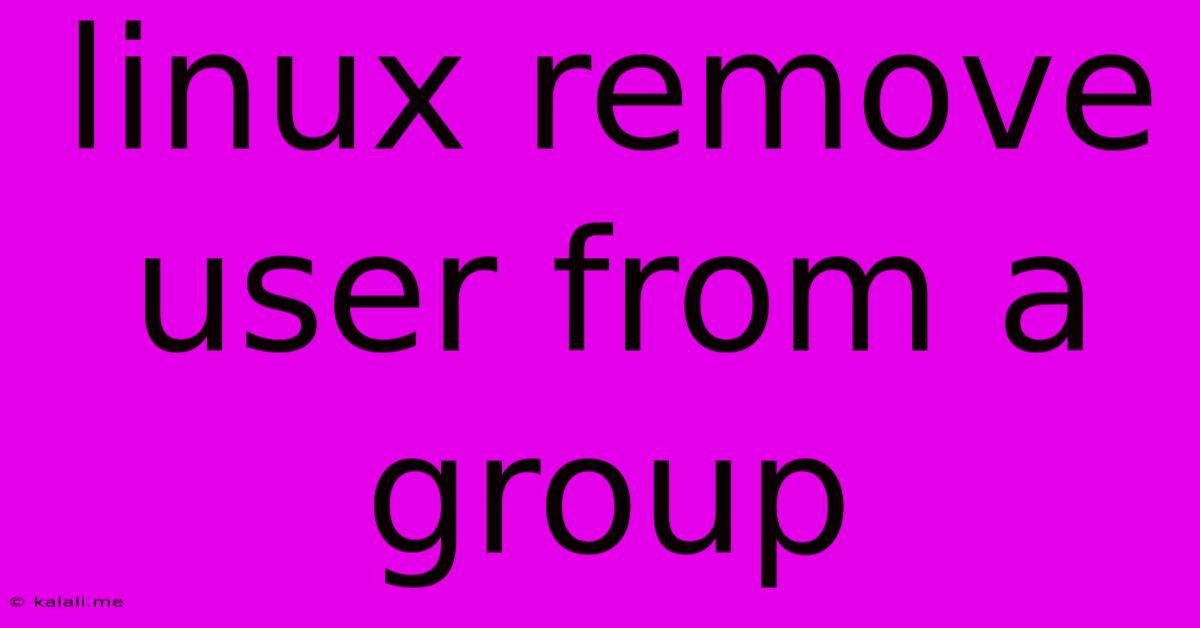Linux Remove User From A Group
Kalali
May 24, 2025 · 3 min read

Table of Contents
Removing Users from Groups in Linux: A Comprehensive Guide
Removing a user from a group in Linux is a fundamental administrative task. This guide will walk you through the process, covering various methods and explaining the implications. Understanding group management is crucial for maintaining system security and proper user permissions. This article will cover different command-line tools and best practices to ensure a smooth and secure process.
Why Remove a User from a Group?
Several reasons necessitate removing a user from a Linux group. These include:
- Security: Removing a user from a group revokes their access to resources and files associated with that group, enhancing system security. This is especially important if a user leaves the organization or if their role changes.
- Access Control: Fine-grained control over user permissions is essential for efficient system management. Removing users from unnecessary groups streamlines access control and reduces potential security vulnerabilities.
- Troubleshooting: Removing a user from a group can help troubleshoot permission-related issues. If a user is experiencing access problems, temporarily removing them from specific groups can isolate the source of the issue.
- Cleanup: Removing users from groups they no longer need helps maintain a clean and organized system. This improves system performance and simplifies future administration.
Methods for Removing Users from Groups
The primary command-line tool for managing groups and users is gpasswd. Here’s how to use it:
Using gpasswd
The gpasswd command offers a straightforward way to remove users. The syntax is:
sudo gpasswd -d username groupname
Where:
sudoelevates your privileges to perform the action.gpasswdis the command for managing groups.-dspecifies the "delete" operation, removing the user from the group.usernameis the name of the user to be removed.groupnameis the name of the group from which the user will be removed.
Example: To remove the user john from the developers group, you would use:
sudo gpasswd -d john developers
Using deluser (Alternatives and Considerations)
While less common, some distributions might offer deluser command. This command is more of a high level user management command and offers to delete the user completely, or modify existing groups. It's often less direct compared to gpasswd.
Verifying the Change
After executing the command, it's crucial to verify the change. You can use the groups command:
groups username
This will list all the groups the specified user belongs to. If the user has been successfully removed, the groupname will no longer appear in the output. For example:
groups john
john : john adm cdrom sudo dip lpadmin sambashare
This shows john is part of several groups, but does not belong to developers.
Important Security Considerations:
- Root Privileges: Remember to use
sudobefore these commands. Modifying group memberships requires root privileges or equivalent administrative access. - Impact Assessment: Before removing users from groups, carefully assess the impact on system functionality and user access. Removing a user from a critical group might disrupt services or applications.
- Auditing: Maintain proper system logs to track changes in group memberships. This is crucial for security and troubleshooting.
- Backup: Before making significant changes, consider backing up your system configuration. This provides a safety net in case of unintended consequences.
By following these steps and best practices, you can effectively manage group memberships in your Linux system, ensuring optimal security and access control. Remember to always prioritize security and thoroughly test any changes in a controlled environment before deploying them to a production system.
Latest Posts
Latest Posts
-
How Many Days Is In 11 Weeks
Jul 14, 2025
-
How Many Grams Are In One Tola Gold
Jul 14, 2025
-
How Many Oz In A Pound Of Freon
Jul 14, 2025
-
How Many Years Are In A Millennia
Jul 14, 2025
-
Words With C As The Second Letter
Jul 14, 2025
Related Post
Thank you for visiting our website which covers about Linux Remove User From A Group . We hope the information provided has been useful to you. Feel free to contact us if you have any questions or need further assistance. See you next time and don't miss to bookmark.